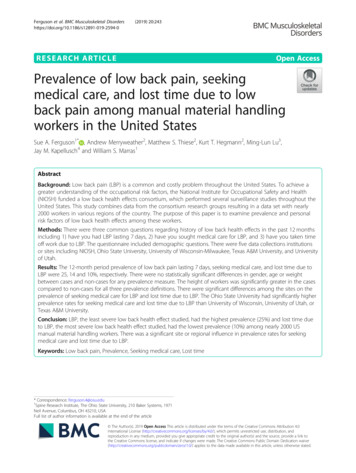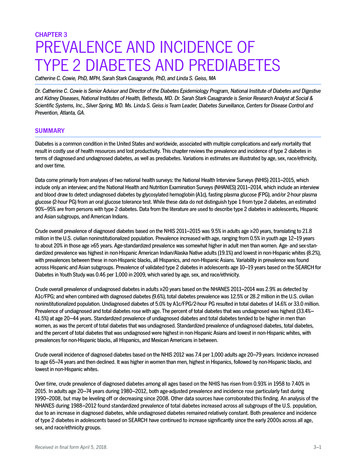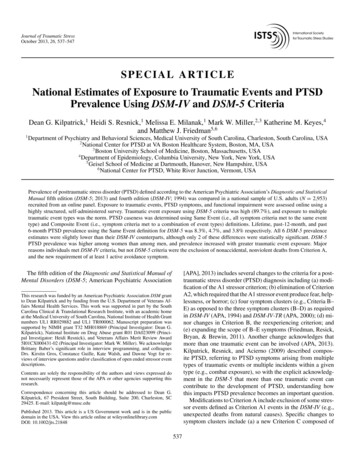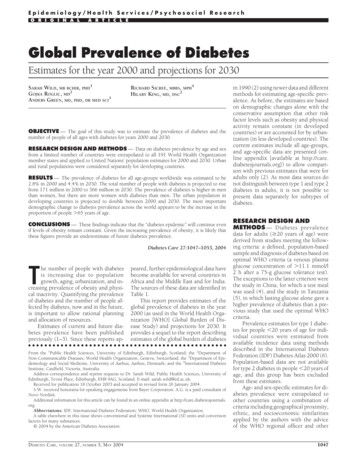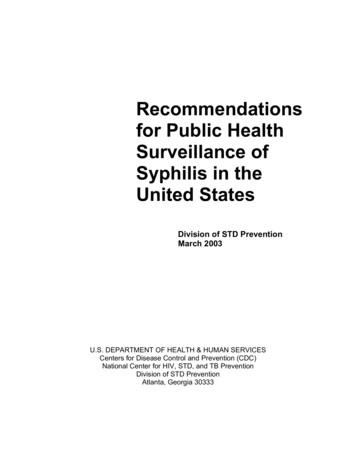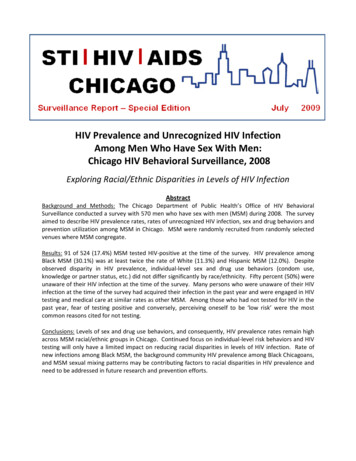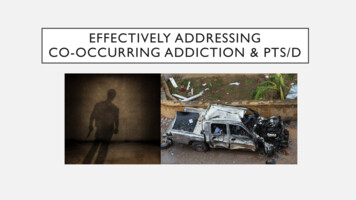
Transcription
Iman’ishimwe Mukamana et al. BMC International Health and Human Rights(2020) RCH ARTICLEOpen AccessTrends in prevalence and correlates ofintimate partner violence against women inZimbabwe, 2005–2015Jeanette Iman’ishimwe Mukamana1* , Pamela Machakanja2 and Nicholas Kofi Adjei3,4AbstractBackground: Intimate partner violence (IPV) is a widespread problem affecting all cultures and socioeconomicgroups. This study explored the trends in prevalence and risk factors associated with IPV among Zimbabweanwomen of reproductive age (15–49 years) from 2005 to 2015.Methods: Data from the 2005/2006, 2010/2011 and 2015 Zimbabwe Demographic and Health Survey (ZDHS) on13,409 women (survey year: 2005/2006; n 4081), (survey year: 2010/2011; n 4411) and (survey year: 2015; n 4917) were analyzed. Multiple logistic regressions and hierarchical modelling techniques were applied to examinethe associations between demographic characteristics, socioeconomic status, media exposure and IPV againstwomen. We further estimated IPV prevalence by type (physical, sexual and emotional) over time.Results: The prevalence of IPV decreased from 45.2% in 2005 to 40.9% in 2010, and then increased to 43.1% in2015. Some of the risk factors associated with IPV were younger age, low economic status, cohabitation and ruralresidence. Educational attainment of women was however not significantly associated with IPV.Conclusions: The findings indicate that women of reproductive age are at high and increasing risk of physical andemotional violence. There is thus an urgent need for an integrated policy approach to address the rise of IPVrelated physical and emotional violence against women in Zimbabwe.Keywords: Intimate partner violence (IPV), Trends, Risk factors, Demographic and health surveys (DHS), ZimbabweBackgroundIntimate partner violence (IPV) refers to any assaultiveand coercive behaviour that causes physical, psychologicalor sexual harm to a person in a relationship [1, 2]. IPV ispervasive globally [2–4], affecting all cultures and socioeconomic groups [5, 6]. Although this type of behaviorcan be perpetrated against men or women, evidence suggests that it is largely perpetrated by male partners againstfemale partners of reproductive age [2, 7]. A recent multicountry study by the World Health Organisation (WHO)[2, 8] revealed that one out of three women experienceseither physical or sexual violence in their lifetime worldwide. There are however regional variations, with theprevalence of IPV being observed to be higher in Africa* Correspondence: m; mukamanaj@africau.com1Institute of Peace, Leadership and Governance, Africa University, Off NyangaRoad Fairview Road, P.O. Box 1320, Mutare, ZimbabweFull list of author information is available at the end of the article(37%) and South-East Asia (38%) than in Europe (25%)and the Americas (30%) [2, 9].IPV against women is a worldwide public health andhuman rights concern [10–12], as it has been shown tobe a risk factor for various physical and mental healthproblems [7, 13–18]. Prior research has demonstratedthat women who are sexually and physically abused bytheir intimate partners have a high risk of developingphysical and mental health problems including traumaticstress, injury, depression infectious diseases such as Human Immunodeficiency Virus (HIV) and even death,compared to those not affected by IPV [7, 17–19].The issue of IPV has become a global priority andthere are efforts and high-level commitments towardsaddressing the issue. For instance, in an attempt tominimize or eradicate violence against women, theUnited Nations (UN) introduced conventions such asthe convention on the Elimination of All Forms of The Author(s). 2020 Open Access This article is distributed under the terms of the Creative Commons Attribution 4.0International License (http://creativecommons.org/licenses/by/4.0/), which permits unrestricted use, distribution, andreproduction in any medium, provided you give appropriate credit to the original author(s) and the source, provide a link tothe Creative Commons license, and indicate if changes were made. The Creative Commons Public Domain Dedication o/1.0/) applies to the data made available in this article, unless otherwise stated.
Iman’ishimwe Mukamana et al. BMC International Health and Human RightsDiscrimination Against Women (CEDAW), amongothers that contain provisions to protect the rights andwell-being of women to directly or indirectly curb therising prevalence of violence against them [20, 21]. Furthermore, the Sustainable Development Goal five targettwo adopted by the UN in 2015 aims at ending all formsof violence against women [22, 23]. Moreover, variousregions and nations have laws that criminalize intimatepartner violence. For example, the African Charter onHuman and People’s Rights (ACHPR)’S chapter 1, article5, emphasizes that “Every individual shall have the rightto the respect of the dignity all forms of exploitationand degradation of man particularly slavery, torture,cruel, inhuman or degrading punishment and treatmentshall be prohibited” [24].Despite the laws and legislations to protect womenagainst violence, IPV is still on the rise in developingcountries [25, 26]. In Africa, several factors including thepatriarchy system, culture and social norms have beenidentified as contributing factors to the rise of IPV in theregion [8, 26]. In general, IPV is tolerated and perceived asa cultural norm and accepted as a means to keep womendisciplined and on track [4, 27–29]. In Sub Saharan Africa,over 75% of wife beating is justified, for example when awoman is deemed as not living up to her husband’s andsociety’s expectations [12, 26]. In some instances, localcommunities tolerate the male use of violence to maintaincontrol over women [4, 26]. Thus, culture has been normalized and viewed as unavoidable in some communitiesover generations [4, 30, 31].Furthermore, having a low economic status has beenshown to increase women’s vulnerability to IPV [4, 32],because they might be financially dependent on theirmale intimate partners. As the average level of educationof African women is usually lower than that of theirmale partners [33], they are more likely to be unaware oftheir rights and of the laws regarding IPV [34–38].The relational approach theory suggests that differencesin educational achievement, age, and carrier developmentmay increase women’s vulnerability to IPV [8, 39]. In somecircumstances, the financial situation of women may exposethem to IPV, especially in conservative societies that usuallystress normative roles of women [8, 25]. Conversely, somemen may resort to violence to enhance their positions [28],especially where they feel powerless and threatened by theirfemale partners’ socio-economic achievements [8, 25].Over the past decades the media has become a critical tool in educating women on IPV in Sub-SaharanAfrica [40], and has been utilized to prevent and respond to violence. Evidence suggests that the mediais effective in raising awareness on IPV [41], and thatit influences attitudes towards gender norms by alerting women and societies about human rights and violations of these rights [42].(2020) 20:2Page 2 of 11The case of ZimbabweThe prevalence of IPV is high in Zimbabwe. According todata from a Demographic Health Survey (DHS) conductedin 2015, about 35% of women had experienced physicalviolence from the age of 15 and 14% had experienced sexual violence once in their lifetime. The report further revealed that 32% of married women had experiencedspousal emotional violence [43]. Other studies further indicated that 40% of women and a third of men acceptedand justified physical chastisement of women [44–46]. Although the Domestic Violence Act 14/2006 law exists inZimbabwe, sexual offenses such as spousal rape, remain awidespread problem in the country [43, 44]. It has beenreported that almost a quarter of married women who experience domestic violence also experience sexual violence[46]. Despite the government’s efforts to incorporate someof CEDAW’s protocols in the Domestic Violence Act, ithas been noted that the government of Zimbabwe has notindorsed elective protocols [47] which are meant to address defilements comparable to individuals complaintsprocedures [48]. The domestication of these protocols hasbeen hindered by poor implementation, administrativepractices by both state and non-state institutions [47].This has negatively impacted women and continues toplace them in a subordinated state [49].In 2010, the Media Monitoring Project Zimbabwe(MMPZ) assessed how Zimbabwe’s mainstream media faredin raising awareness of gender-based violence [50, 51]. Although the media is crucial in alerting communities and theauthorities of these trending problems, MMPZ found thatgender based violence only emerged as a secondary concernin the media [51]. In fact, it was observed that the mediahad not shown much inclination in raising awareness aboutgender based violence issues, even during the 16 days of activism against gender based violence campaign. Although,the media is a critical source of information on IPV issues[52, 53], studies on the influence and impact of the mediaon IPV are limited [12, 52–55].As discussed previously, socioeconomic and culturalfactors have been identified to be associated with IPVin some developing countries [4, 30, 33]. However, tothe best of our knowledge, no study has examinedthe relationship between these factors and IPV inZimbabwe, over time. The objective of this study isto explore the trends in prevalence and risk factorsassociated with IPV against women in Zimbabwefrom 2005 to 2015. The following research questionswill be addressed.1) How do demographic characteristics andsocioeconomic status (SES) of women influenceIPV?2) To what extent does media exposure of womenimpact their experience of IPV?
Iman’ishimwe Mukamana et al. BMC International Health and Human RightsMethodsThe data for this study were from the 2005/2006, 2010/2011 and 2015 Zimbabwe Demographic and Health Surveys (ZDHS) [43]. The data are based on nationally representative surveys of men and women in theirreproductive age that are undertaken by the ZimbabweNational Statistical Agency in collaboration with otherinternational organizations. The ZDHS employed a twostage stratified cluster sampling technique based on census enumeration areas (EAs) and household samples.The first stage was the selection of EAs in both ruraland urban areas with probability proportional to the size,and the second stage involved household sampling. Forthis study, we limited our sample to currently marriedor cohabiting women aged 15–49 years. The samples forthe final analyses after the exclusions were (survey year:2005/2006; n 4081), (survey year: 2010/2011; n 4411)and (survey year: 2015; n 4917).Measurement of the outcome variableThe outcome variable in this study was IPV. This variable was a combination of at least one type of intimatepartner violence (physical, sexual or emotional) experienced by a woman. In the survey, the questions posed towomen were for example “Did your husband or partnerever: slap you, push you, kick you, punch you or beatyou up”? These questions were used to derive physicalviolence. Sexual violence was assessed by the questions:“Did your husband or partner ever: physically force youto have sexual intercourse with him even when you didnot want to”? Or force you with threats to perform anysexual acts you did not want to? Further, women wereasked whether their partner “said or did something to humiliate them in front of others,” “threaten to hurt or harmthem” or “insult them to feel bad about themselves.”These set of questions were used to derive emotional violence. Responses were grouped and answers in the affirmative were categorized as ever experienced physical,sexual or emotional violence and coded “1”, while thosewho never experienced any form of intimate partner violence were categorized otherwise and coded “0”.Independent variablesThe independent variables were group together intothree broad categories: sociodemographic characteristics,socioeconomic status (SES) and exposure to media. SESwas categorized using three measures: educational level(no formal education, primary, secondary or higher education), employment status (currently employed, notcurrently employed) and wealth index (poorest, poorer,middle and richer). The sociodemographic characteristics considered were age (15–19, 20–24, 25–29, 30–34,35–39, 40 ), marital status (married, cohabiting), number of children (no child, 1–2, 3–4, 5 ), place of(2020) 20:2Page 3 of 11residence (rural or urban) and religious affiliations(Christians, Moslems, traditionalist, no religion). Exposure to media (newspaper, radio or television (TV)) wasassessed in terms of frequency (no exposure, less thanonce a week, at least once a week). These explanatoryvariables were chosen to capture the individual and social context of IPV. All the variables were obtained fromtwo types of questionnaires: the individual women’s andhousehold questionnaire. The individual women’s questionnaire provided information on the women (i.e.,demographic, socioeconomic and lifestyle characteristics) while the household questionnaire provided information on household possessions and amenities such assanitation facilities, source of drinking water and household’s ownership of selected assets, which were used tocreate the “wealth index” [56].Statistical analysisDescriptive and multiple regression analyses were performed in this study. In the first part of the analysis, percentages (%) were used to describe the prevalence andtrends of IPV. Differences in IPV prevalence rates between the three survey years were examined using chisquare test. In the second part, binary logistic regressionmodels were fitted to examine the associations betweenthe independent variables and IPV using pooled datafrom 2005 to 2015. The binary logistic models estimatethe likelihood of the outcome variable to be 1 (h 1),and the conditional probability of experiencing the outcome (IPV) can be expressed mathematically as:pr ðh ¼ 1jxÞ ¼expðxβÞ1 þ expðxβÞThe regression analysis was carried out using a threestep hierarchical modeling approach. This step-wisestrategy allowed us to examine the independent impactof the groups of explanatory variables on the outcomevariable. In the first model, logistic regression modelswere adjusted for sociodemographic characteristics. Toexamine the impact of women’s social status on IPV,SES variables were added in the second step (Model 2).Finally, media exposure variables were fitted in model 3.The prevalence of IPV and odds ratios with 95% confidence intervals (95% CI) was calculated using Stata Version 14 (Stata Corp, College Station, Texas, USA). Allanalysis were weighted to adjust for the DHS samplingdesign.ResultsTrends over time in the prevalence of intimate partnerviolence (physical, sexual or emotional)Table 1 presents the prevalence of IPV by sociodemographic characteristics, socioeconomic status (SES) and
(2020) 20:2Iman’ishimwe Mukamana et al. BMC International Health and Human RightsPage 4 of 11Table 1 Prevalence of IPV by sociodemographic characteristics,socioeconomic status and media exposure among women ofreproductive age (15–49 years) by survey year, Zimbabwe,2005–2015Table 1 Prevalence of IPV by sociodemographic characteristics,socioeconomic status and media exposure among women ofreproductive age (15–49 years) by survey year, Zimbabwe,2005–2015 (Continued)VariablesVariables2005/2006(n 4081)2010/2011(n 4411)2015(n 4917)IPV (%)IPV (%)IPV (%)15–1943.6644.7543.96Age2005/2006(n 4081)2010/2011(n 4411)2015(n 4917)IPV (%)IPV (%)IPV (%)No Media Less than once a week49.3341.5044.0825–2946.2244.3447.22At least once a .2137.6241.61No Media exposure48.6541.9943.3540 46.1534.1036.05Less than once a week41.4543.2743.12At least once a week40.3838.0142.64TelevisionMarital .77No 41.5944.275 65Traditionalist53.6857.1455.81No Religion49.6444.8354.68Number of childrenPlace of residenceReligionEducational LevelNo ndary and higher43.9238.7541.96Employment StatusNot currently employed41.1838.7340.67Currently .3038.10No Media exposure48.0443.1844.5Less than once a week42.8838.3041.1At least once a week38.5034.2641.5Wealth (Index)Media exposureNewspaperaTotal45.23a40.9743.10aaNote: values with the same superscript are significantly different betweenthe surveys at p 0.05media exposure, from 2005 to 2015. Prevalence by agegroup and trends in prevalence of physical, sexual andemotional violence are shown in Figs. 1 and 2 respectively.The overall prevalence of IPV decreased from 45.2% in2005/2006 to 40.9% in 2010/2011 (P 0.001). However,in 2015, the prevalence increased marginally to 43.1%(P 0.01) (Table 1). Regarding the various forms of IPV,the prevalence of sexual violence decreased from 13.2%in 2005 to 10.6% in 2015, but trends in physical andemotional violence showed a fairly similar pattern in2005 (physical violence – 28.7%, emotional violence –30.0%) and 2015 (physical violence – 29.5%, emotionalviolence – 29.6%) (Fig. 1).In general, the prevalence of IPV increased with age toa maximum in the middle age (25–29 years), then decreased in the older age groups (35 years and above).While the prevalence of sexual and physical violence washigher among the younger age groups, emotional violence was generally similar across all age groups (Fig. 2).The prevalence of IPV was generally higher among cohabiting than among married women. Whereas theprevalence among married women decreased between2010 (45.2%) and 2015 (42.7%), it increased remarkablyamong cohabiting women over the same period from46.6 to 50.7%. Regarding the number of children, theprevalence of IPV was higher among women with children and it increased as the number of children increased across all the survey years.Further exploration with respect to the place of residence showed that women in the rural areas had ahigher prevalence than those in urban areas. However,over the survey period, we observed an increase in thetrend of the prevalence of IPV among women who livedin the urban areas, from 38.3% in 2005 to 43.0% in 2015,
Iman’ishimwe Mukamana et al. BMC International Health and Human Rights(2020) 20:2Page 5 of 11Fig. 1 Prevalence of IPV among women of reproductive age (15–49 years) by survey year, Zimbabwe, pooled data, 2005–2015equalling that of women who lived in the rural areas in2015 (43.0%). Regarding religion, the prevalence of IPVwas higher among traditionalist women. Nonetheless, itdecreased marginally from (57.1%) in 2010 to 2015(55.8%).By stratifying the data according to socioeconomic status (SES), we observed that over time, the prevalence ofIPV was lower, among women with higher socioeconomicstatus (Table 1). Despite this finding, we observed an increase in the prevalence among this sub-group with higherSES, from 32.6% in 2005 to 38.1% in 2015. Meanwhile, theprevalence of IPV among the poorest decreased considerably from 50.8% in 2005 to 44.9% in 2015.The trend analysis showed no consistent pattern in theprevalence of IPV over time, in terms of frequency ofmedia exposure. However, we observed that the prevalence was relatively higher among women who had notbeen exposed to media (i.e. newspaper, radio ortelevision).Logistic regressionThe results of the adjusted odd ratio (OR) and 95% confidence intervals (CI) for the association between sociodemographic characteristics, SES, media exposure andIPV in a three step hierarchical model are shown inTable 2.In model 1, based solely on sociodemographic characteristics of women, an association between women’s ageand IPV was observed. Older women (40 years) wereless likely to experience IPV (aOR 0.68; 95% CI 0.55–Fig. 2 Prevalence of IPV among women of reproductive age (15–49 years) by age group, Zimbabwe, pooled data, 2005–2015
Iman’ishimwe Mukamana et al. BMC International Health and Human Rights(2020) 20:2Page 6 of 11Table 2 Multivariate associations between sociodemographic characteristics, socioeconomic status, media exposure and IPV amongwomen of reproductive age (15–49 years), Zimbabwe, pooled data from 2005 to 2015Model 1aModel 2bModel 3caOR (95% CI)aOR (95% CI)aOR (95% CI)20–241.04 (0.88–1.2)1.01 (0.85–1.1)1.01 (0.85–1.20)25–291.03 (0.87–1.23)0.98 (0.82–1.17)0.95 (0.84–1.07)30–340.86 (0.71–1.03)0.80 (0.67–0.97)**0.76 (0.66–0.87)***35–390.78 (0.64–0.95)**0.72 (0.59–0.89)***0.69 (0.59–0.80)***40 0.68 (0.55–0.83)***0.63 (0.51–0.78)***0.58 (0.49–0.68)***1.32 (1.12–1.57)***1.27 (1.07–1.50)**1.26 (1.05–1.51)**1–21.44 (1.28–1.68)***1.43 (1.23–1.68)***1.37 (1.23–1.68)***3–41.61 (1.35–1.92)***1.60 (1.35–1.91)***1.59 (1.33–1.92)***5 1.93 (1.57–2.36)***1.88 (1.54–2.31)***1.93 (1.55–2.40)***1.10 (1.02–1.18)**0.87 (0.79–0.97)**0.85 (0.76–0.96)**Moslems1.48 (0.90–2.43)1.46 (0.90–2.43)1.75 (0.98–3.14)*Traditionalist1.26 (0.95–1.67)1.18 (0.89–1.58)1.29 (0.95–1.76)1.24 (1.09–1.41)***1.24 (1.08–1.41)***1.24 (1.08–1.43)**Primary1.10 (0.88–1.37)0.96 (0.76–1.22)Secondary and higher0.96 (0.88–1.04)0.92 (0.72–1.17)1.51 (1.40–1.63)***1.50 (1.38–1.62)***Poorer1.10 (0.99–1.23)*1.08 (0.96–1.21)Middle0.89 (0.80–0.98)**0.88 (0.79–0.99)**Richer0.62 (0.53–0.72)***0.64 (0.54–0.77)***VariablesAge15–19 (ref)Marital StatusMarried (ref)CohabitingNumber of childrenNo child (ref)Place of residenceUrban (ref)RuralReligionChristians (ref)No ReligionEducational LevelNo education (ref)Employment StatusNot currently employed (ref)Currently employedWealth (Index)Poorest (ref)Media exposureNewspaperNo exposure (ref)Less than once a week0.94 (0.85–1.04)At least once a week0.95 (0.82–1.08)RadioNo exposure (ref)
Iman’ishimwe Mukamana et al. BMC International Health and Human Rights(2020) 20:2Page 7 of 11Table 2 Multivariate associations between sociodemographic characteristics, socioeconomic status, media exposure and IPV amongwomen of reproductive age (15–49 years), Zimbabwe, pooled data from 2005 to 2015 (Continued)VariablesModel 1aModel 2baOR (95% CI)aOR (95% CI)Model 3caOR (95% CI)Less than once a week1.06 (0.95–1.16)At least once a week1.07 (0.98–1.18)TelevisionNo exposure (ref)Less than once a week1.02 (0.89–1.16)At least once a week1.03 (0.90–1.15)Observations13,40913,40913,409Pseudo R20.01430.02370.0341Log Likelihood 9033.5425 8946.9156 7871.9548Notes: aOR- adjusted Odd Ratio, *** p 0.001, ** p 0.01, * p 0.05. Regression includes age at first cohabitationaIncludes sociodemographic characteristics variablesbIncludes sociodemographic and socioeconomic status (SES) variablescIncludes sociodemographic, socioeconomic status (SES) and media exposure variables0.83) compared to younger women (15–19) years. Wealso found marital status to be strongly associated withIPV, whereby cohabiting women had higher odds ofreporting IPV (aOR 1.32; 95% CI 1.12–1.57) compared to married women. The number of live children ofwomen was significantly associated with IPV. Womenwho had more children (e.g. 3–4) were more likely toexperience IPV (aOR 1.61; 95% CI 1.35–1.92) compared to their counterparts without children. Religionwas also strongly associated with IPV, with women withno religious affiliation having a higher likelihood ofreporting IPV (aOR 1.24; 95% CI 1.09–1.41) compared to Christians. The regression analysis also confirmed the role of geographical area or location.Considering only sociodemographic characteristics ofwomen, we observed that women living in the ruralareas were about 10% more likely to be report IPV(aOR 1.10; 95% CI 1.02–1.18) compared to theircounterparts in the urban areas.With the inclusion of SES in model 2, all the sociodemographic characteristics of women maintained theirsignificant influence on the experience of IPV, exceptplace of residence. Adjusting for SES attenuated the association between the place of residence of women andIPV, whereby women living in the rural areas were nowless likely to report IPV (aOR 0.87; 95% CI 0.79–0.97) compared to their counterparts in the urban areas.In the model, wealth and employment status of womenshowed significant effects on the likelihood of experiencing IPV. Richer women had lower odds of reportingIPV (aOR 0.62; 95% CI 0.53–0.72) compared to thepoorest. We also observed a strong association betweenemployment status and IPV, with women who wereemployed being about 50% more likely to report IPV(aOR 1.51; 95% CI 1.40–1.63) compared to those notemployed. Educational attainment of women was however not significantly associated with IPV in both model1 and 2. When media exposure of woman was introduced in the full model (Model 3), we observed a significant reduction in the effect sizes of sociodemographiccharacteristics on IPV. However, media exposure (i.e.newspaper, radio or television) of women was not significantly associated with IPV.DiscussionIPV against women has not only been widely investigated in the extant literature, it has also drawn much attention in state organisations as well as in theinternational community. Nonetheless, this is the firststudy to examine the trends in the prevalence and riskfactors of IPV against women in Zimbabwe, using DHSdata collected from 2005 to 2015. Overall, the results revealed that the prevalence of IPV decreased from 45.2%in 2005 to 40.9% in 2010, and then increased again to43.1% in 2015. Regarding the various forms of IPV, theprevalence of emotional violence, the most popular formof IPV against women in Zimbabwe and other Sub Saharan African countries [57] was generally similar acrossall age groups. The results further showed that age wasinversely associated with increased experience and vulnerability to IPV, with the younger age groups beingmore affected than the older ones. This pattern is consistent with other previous studies [45, 58–60] thatfound IPV to be higher among younger adults becausethey are likely to engage in aggressive and violent behaviours [45, 58]. Young women who are in unions may bevulnerable to IPV due to lack of educational opportunities, power inequalities [61–63] and they are more likelyto depend on their partners [64–66] than older women.This may limit their autonomy in unions [61], and their
Iman’ishimwe Mukamana et al. BMC International Health and Human Rightslack of autonomy may encourage and increase controlfrom their partners.The findings revealed a pattern where the prevalence ofIPV increased as the number of children increased. A possible explanation for this phenomenon is that women maynot want to leave their matrimonial homes as they maytend to secure the welfare of their children as well as fearof losing offspring [67]. On the other hand, pregnancy hasbeen shown to increase the risk of IPV [68–70], and thisphenomenon has been attributed to economic dependency of women [68, 71, 72]. The results are also in linewith those studies which concluded that the prevalence ofIPV was higher among cohabiting women as compared tomarried women [73]. Our findings that the prevalence ofIPV was higher among women in the rural areas andamong traditionalist probably has to do with the perception that the traditionalist, whose proportion is higher inrural areas [74], are deeply rooted in culture and stress theissue of traditional beliefs that justify male dominance andabusive acts [27, 45]. Furthermore, dominant traditionalfemininity practices that encourage hegemonic masculinities, characterised by women’s subordination and accommodation of men’s interest may encourage and justifyviolence against women [75–77].Surprisingly, we did not find any significant associationbetween education level and IPV. While our findings areconsistent with some prior studies [8], other studiesfound education to be protective of IPV [78, 79], as it reduces acceptance of wife beating and other forms ofabuse [80]. The findings of two other studies clearlydemonstrate the controversy related to this aspect.Whereas Lawoko and colleagues [81] found education tobe crucial in reducing the risks of experiencing IPVamong Kenyan women, Taillieu and Brownridge [82] observed that higher education attainment of women increased the risk of experiencing IPV. The controversymight arise from the fact that having a higher educationmay be related to political knowledge and participationin decision making [83], thereby enabling women tochallenge abusive practices and make decisions. This actmay eventually threaten the superiority of men, who inturn might resort to the use of coercive power to protecttheir identity. In other studies, women with low levels ofeducation were found to be more likely to experiencesexual violence [12, 31, 84]. Despite these mixed findings, we speculate that empowerment of women througheducation does not shield them from being abused.Regarding economic status, the results showed thatwealth and employment status of women had potentialimpacts on IPV, which is consistent with findings of previous studies [39, 84, 85]. The observation that employedwomen were more likely to report IPV than their unemployed counterparts has been linked to the view thatemployed women devote less time to traditionally(2020) 20:2Page 8 of 11prescribed roles such as household chores [8, 86], whichmay result in spousal conflict [86–88]. The employmentstatus of a woman might also threaten the partner’s status and role as the family breadwinner, especially i
ical tool in educating women on IPV in Sub-Saharan Africa [40], and has been utilized to prevent and re-spond to violence. Evidence suggests that the media is effective in raising awareness on IPV [41], and that it influences attitudes towards gender norms by alert-ing women and societies about human rights and vio-lations of these rights [42].
